|
Monday, May 26, 2008
Progress Notes
A week and half ago we enjoyed the company of a good many Miller County citizens who
attended our open house. I mentioned it briefly last
week including a few photos. This week I thought I would give a brief photographic
tour of our museum which has undergone a complete renovation of the original building and
the construction of a new building joining it of the same size. The main entrance foyer of
the museum which faces Highway 52 features the paintings of Francesca Wright, Miller
County painter, who moved to New Mexico early in her life and became a famous artist (photo 01). In 1996 she wrote her
autobiography, named Wildwood Days (photo
02) which is an exceptionally interesting account of the rural hill life
experienced by Miller County natives in the early part of the last century.
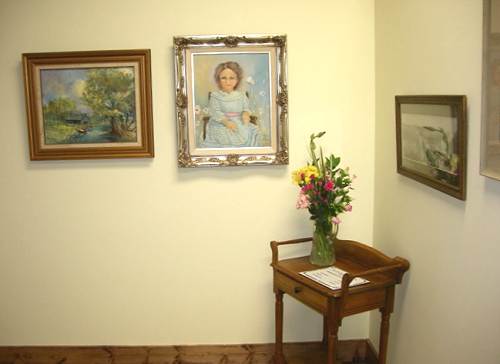
01 Entrance
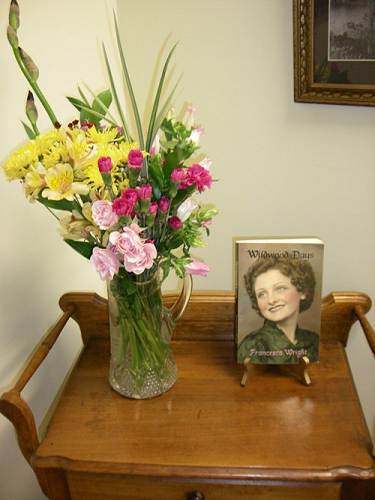
02 Wildwood Days
In 1980 she returned to Miller County and gave a tour featuring many of her
paintings in several exhibits throughout the area. The next photo is a copy of a newspaper
article written in 1980 for the Autogram giving a short history of her life and
accomplishments (photo 03); and the
next photo of her, which uses her married last name, is taken from that same article (photo 04).
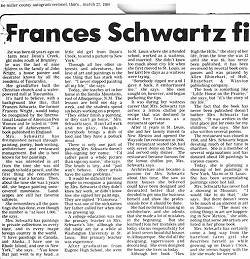
03 Frances Schwartz Narrative
|
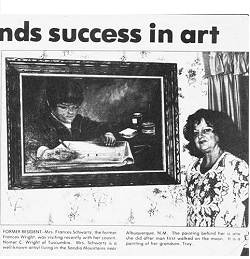
04 Frances Schwartz Photo
|
| Click
images above for larger view |
Before leaving the entry way don't forget to sign the guest book behind
you where Brice Kallenbach is watching to make sure you do (photo 05)! Brice refinished this wall desk for which we are
very grateful.
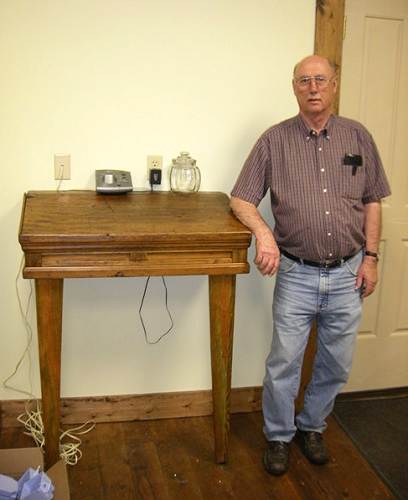
05 Brice Kallenbach by Guest Book
When you step into the main area look to your right to see the displays
representing a time line from prehistoric days up through the First World War (photo 06).
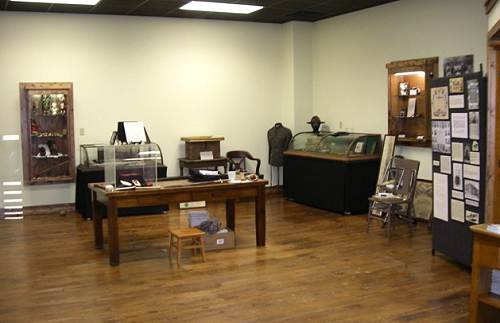
06 Timeline
Next, turning to the part of the main area behind you, is the "dog
trot" home which on one side contains a kitchen separated by a walkway from the other
side which is a bedroom. In this next photo you are looking through the window of the
kitchen at an old wood burning cook stove (photo
07).
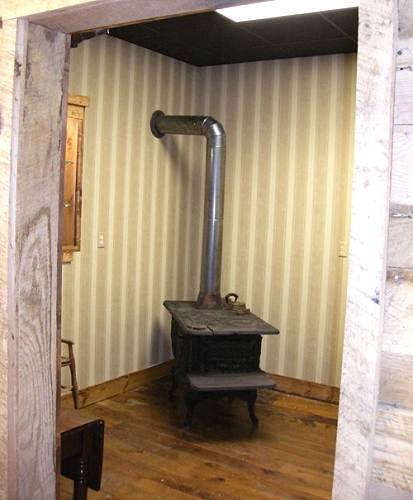
07 Kitchen
On the other side of the pass-through between the two cabins you see the bedroom (photo 08) which contains a large chifarobe (photo 09).
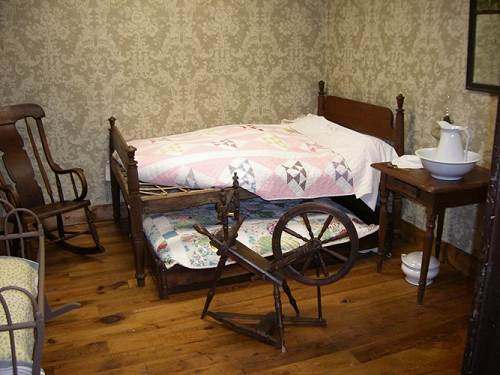
08 Bedroom
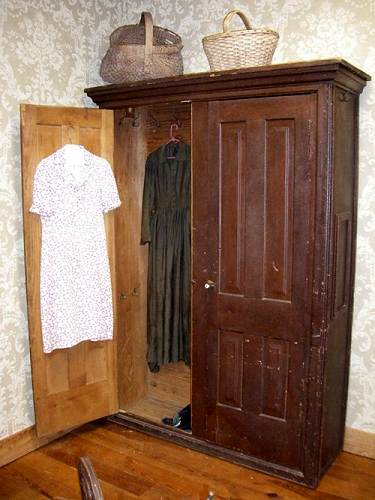
09 Chiffarobe
This piece of furniture took the place of a small closet since long ago the early
homes did not have built in closets. Usually, the absence of closets was to save building
costs but also, in some places, taxes were based on the number of rooms a house had. So a
chiffarobe also could have been used as a tax avoidance device. This chiffarobe was
donated to us by Patsy (Adcock) Wyrick. She inherited it through the Adcock side of her
family originally found in the home of her great grandfather, Samuel Adcock. The builder
of the chiffarobe is not known for sure. However, it is known that George Bear (my great
great grandfather) built chiffarobes and since his granddaughter, Elizabeth Bear, married
Samuel Adcock the possibility exists the builder was George Bear.
The next building on this tour of a small rural settlement in Miller County is the
doctor's office (photo 10). Following
that is a small church (photo 11)
which features a wedding dress, a preacher's frock and a small casket in addition to an
old pump organ. All these items are of Miller County origin (including the pew) and have
an interesting history which you can read when you come to visit the museum.
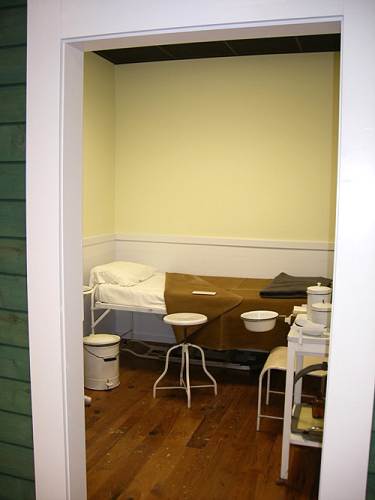
10 Doctor's Office
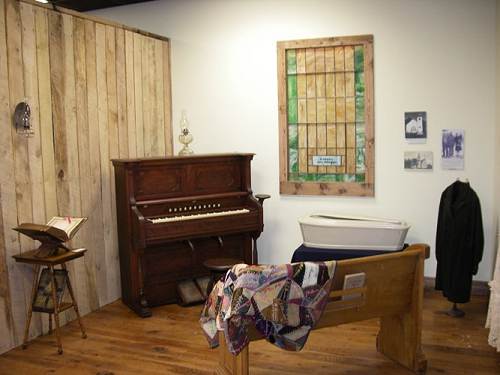
11 Church
As you turn the corner you come to the small country store (photo 12). Next to it is the barber shop which has on display
the original barber chair used in Tuscumbia (photo
13).
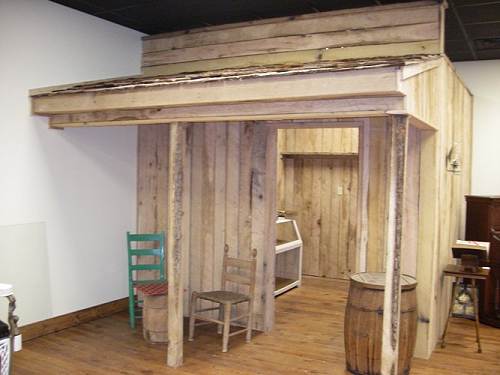
12 Country Store
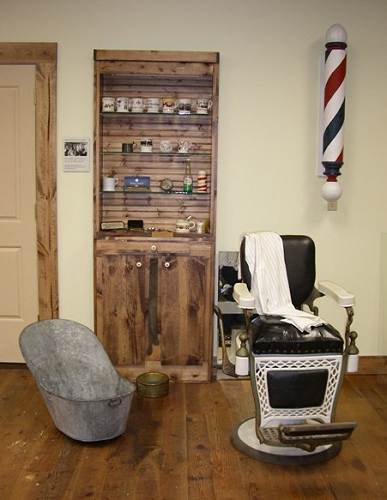
13 Barber Shop
As you turn again to the left you come to the area of spinning and weaving and
the making of clothing. The large loom (photo 14)
was once used on the farm of John Williams of Iberia as far back as before the Civil War,
and afterward was used in the Iberia Academy for many years to teach the skills of
weaving. You can see the beautiful dresses modeled behind the loom which are amazingly
intricate in design, which are from approximately the same time period as the loom and
spinning wheel (photo 15).
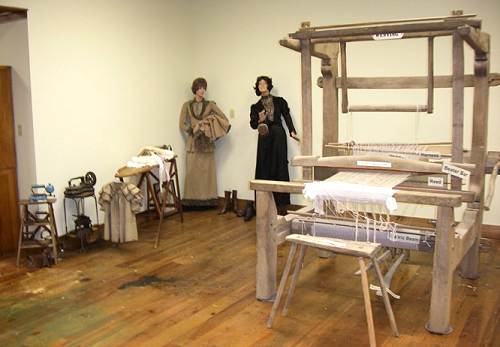
14 Weaving and Wearing
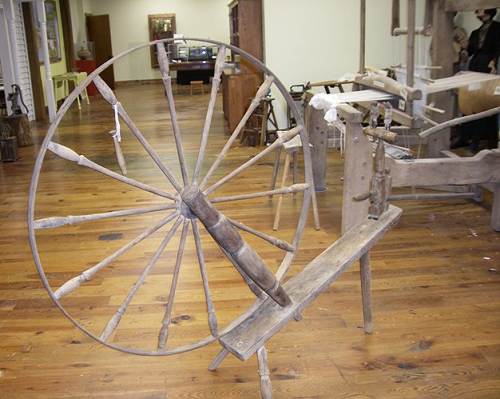
15 Spinning Wheel
Turning to the other side of the large display room you pass through a corridor
leading to the newly added eastern section of the museum. In this corridor is located an
old one room school (photo 16). This
room is a replica of the almost one hundred one room rural schools which were located
throughout Miller County before consolidation in the early 1950's.
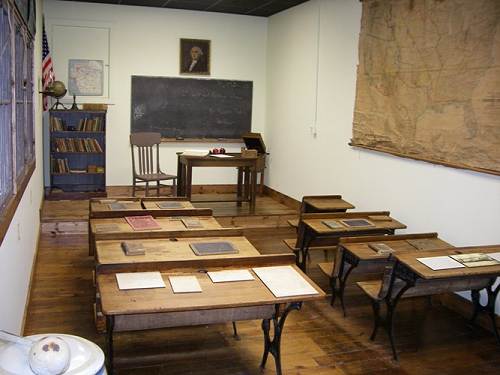
16 One Room School
You can read more about the one room schools at this location on our website:
http://www.millercountymuseum.org/schools.html
Don't miss visiting this site. One of the pages has a map which locates most of the one
room schools established in the county.
After visiting the school continue into the next large open area which contains the
research library (photo 17), various
displays including quilts (photo 18),
a children's play area (photo 19), and
the Lee Mace display (photo 20) which
I discussed last week.
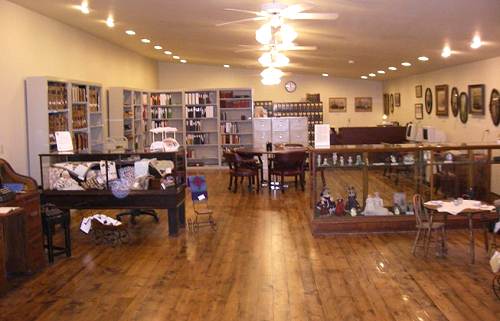
17 Research Library
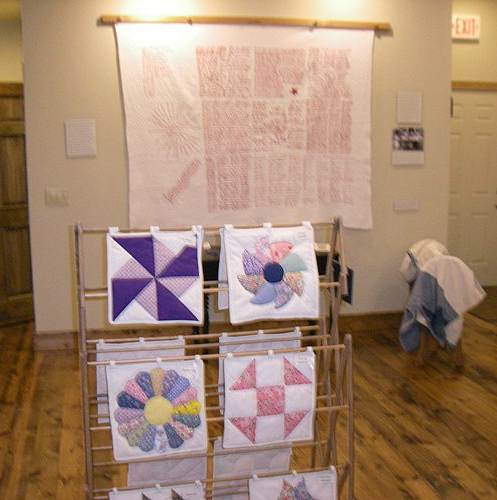
18 Quilt Display
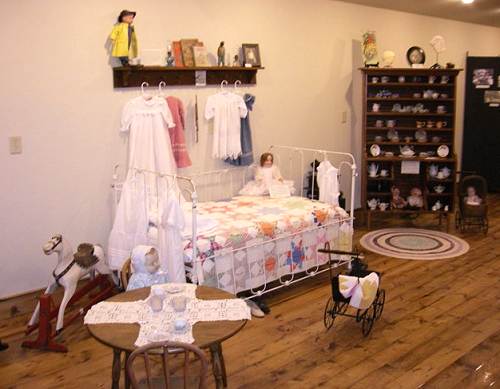
19 Children's Play Area
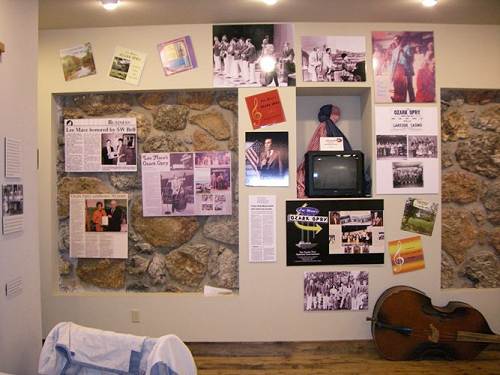
20 Lee Mace Display
On the wall are framed photographs of many of Miller County's better known
citizens of the past; for example Johann Valentine Kallenbach (photo 21), the original Kallenbach who migrated here from
Germany near the end of the civil war and who is the antecedent of all the Kallenbachs'
who have resided here since.
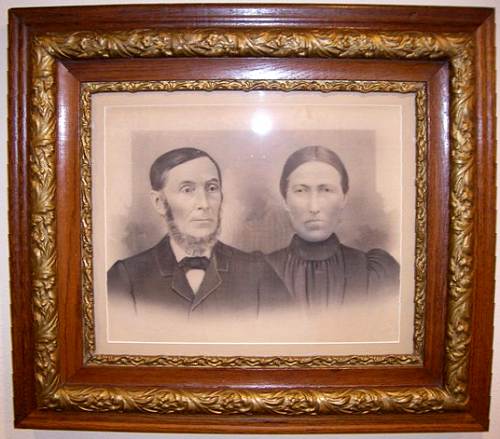
21 Johann Valentine Kallenbach and wife Maria
We have quite a few items in our museum from the Kallenbach family including an
old double barrel muzzle loading shotgun fired by caps (photo 22) which is hanging above the door in the kitchen of
the dogtrot house located in the west side of the museum.
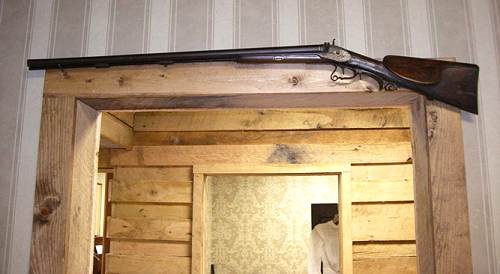
22 German Double Barrel Shotgun
Many other items are on display in this wing of the museum which you will want to
see including the Iberia Academy wall display (photo
23), an old roll top desk with some of the first made mechanical typewriters (photo 24) and a children's doll house
donated by Dr. and Mrs.(Carol) Haggerty which I featured last week (photo 25).
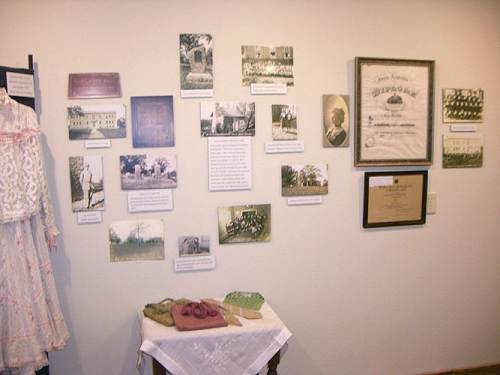
23 Iberia Academy
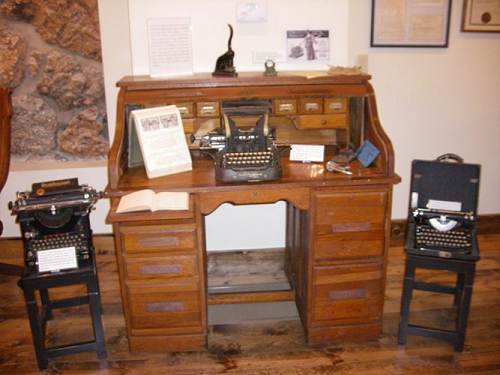
24 Roll Top Desk with Old Typewriters
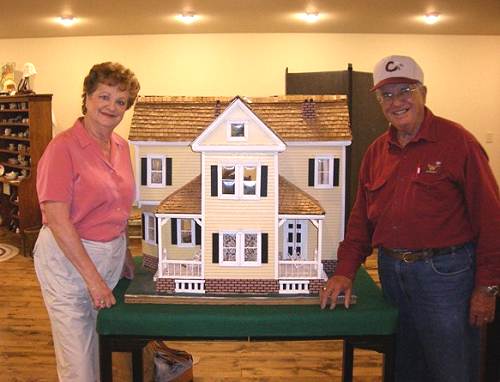
25 Dr. and Mrs. Clem Haggerty
Going down the stairway on the south side of this wing of the museum you enter
the large meeting room which also has displays to view. The theme of this area is Miller
County Transportation during its early history. The first major means of delivering goods
for commerce I will introduce by a few introductory clues. First, look at this photo (photo 26).
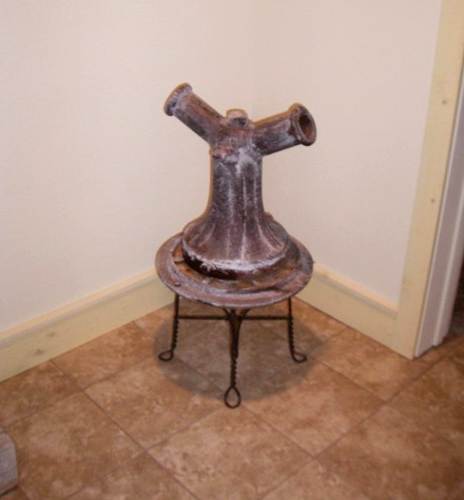
26 Capstan
This heavy metal object is called a capstan. And it was used in conjunction with
the rope featured in this photo (photo 27).
The heavy rope was wound around the capstan by workers who, after inserting wooden poles
in each arm of the capstan, would turn the capstan winding the rope around it. The other
end of the rope may have been attached to an anchor.
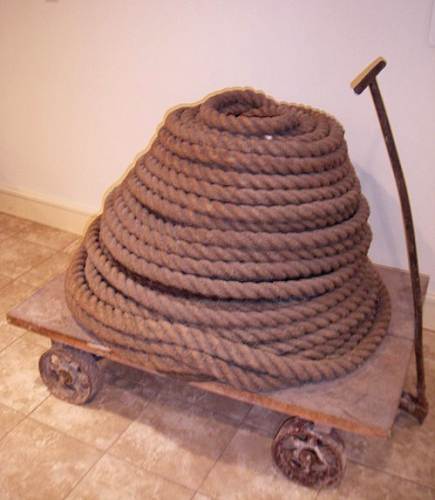
27 Heavy Rope
The next part of this means of transportation is this wheel (photo 28):
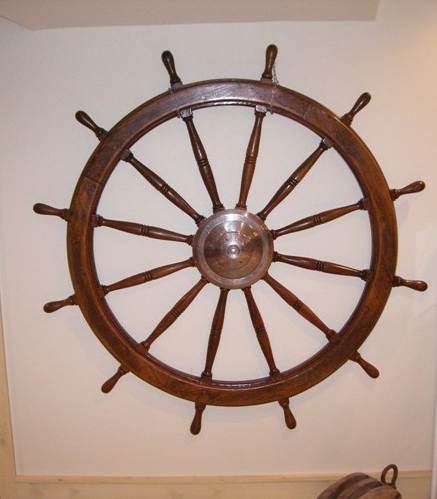
28 Wheel
The last photo in the series tells you what it this means of transportation
was….. a steamboat (photo 29)!
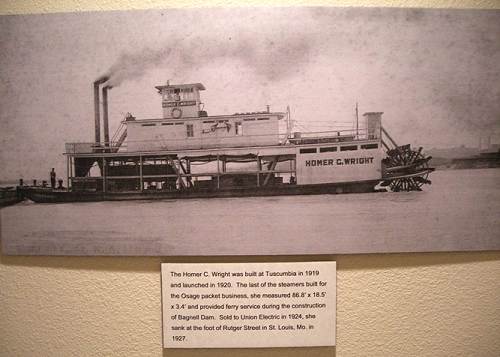
29 Steamboat Homer C. Wright
Our website covers the subject of steamboats at this location:
http://www.millercountymuseum.org/rivernav.html
The steamboats lost their allure for shipping goods when the railroad industry decided
to use Eldon as the major shipping point in Miller County.
The west wall of the meeting area features photos having to do with the railroad (photo 30). Several weeks ago (April 7, 2008) I featured a long narrative about
Miller County railroads.
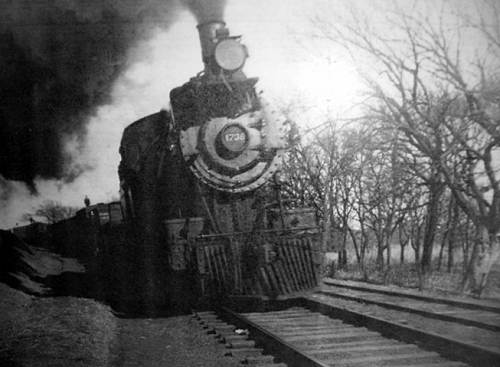
30 Rock Island Steam Engine
Surprising as it may be wagons or carts pulled by oxen were not uncommon in
Miller County up through the Civil War (photo 31).
But don't forget the bicycles (photo 32)
and the baby carriages (photo 33)!
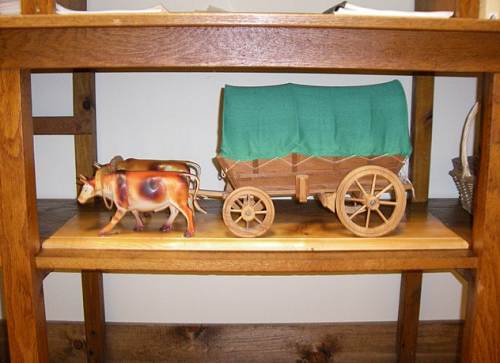
31 Ox and Wagon
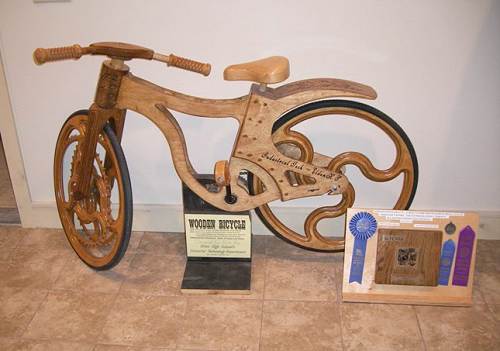
32 Wooden Bicycle made by Eldon Voc Tech School
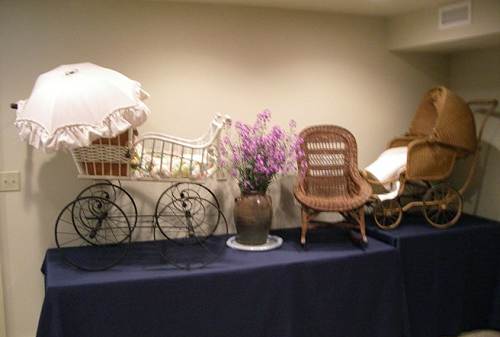
33 Baby Carriages
The old barber chair donated to the museum by Tennyson and Sue Jarrett has stimulated
quite a bit of discussion among visitors to the museum. My mother, who as a girl rode her
tricycle up and down the sidewalk in front of the old barber shop, remembered the first
woman, as far as anyone knows, who dared enter the barber shop for a hair cut. I asked her
to tell the story as well as something about hair styles back in the 1920's and thirties:
The Changing of Hairstyles in Tuscumbia
Susie Bear Pryor (photo 34)
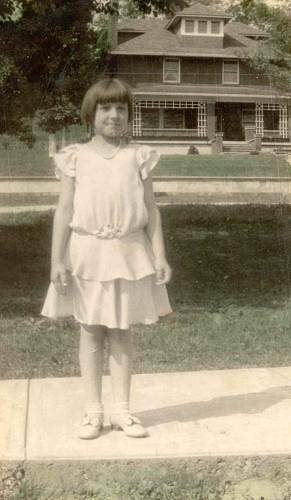
34 Susie Bear Pryor - Age 8
Joe, my son, and I were discussing the old barber
chair that the last owner, Tennyson and Sue Jarrett, had donated to the Historical
Society. This chair had been used in Tuscumbia by many different barbers and who knows who
had it first. We tried to remember as many of the Barbers' names who had cut hair in
Tuscumbia and I couldn't remember more than a half-dozen or so. The one farthest back in
my memory was Edgar Hicks and I well remember an incident when he was Barber which
happened when I was perhaps seven years old. My Mom and Dad had a General Store facing the
Osage River and the Farmer's Exchange was next door to us. The managers of it were Clyde
and Gertie Wyrick (photo 35).
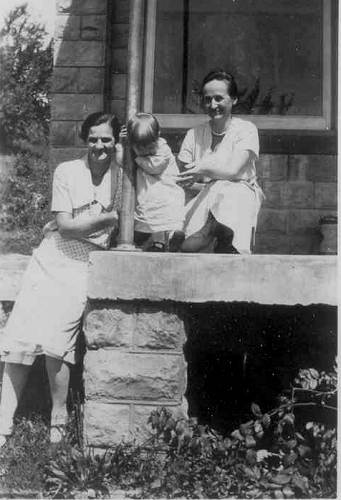
35 Gertie Wyrick (Left) - Sadie Bear (Right)
We were all good friends I was telling Joe I could
well remember the time that Gertie decided to have her hair cut. She didn't tell anyone
ahead of time and somehow or other got up the nerve to walk into Edgar's Barber Shop to
get it done. Then she came over to the store to show off her new hair style and I was
shocked! I thought she had ruined herself forever. She had long black hair that hung down
her back and her usual method of doing her hair (as was the method of every other woman at
the time) was to twist it and pull it up on top of her head winding it around into a neat
knot then pinning it up with hair pins to hold it there so it wouldn't fall down.
So she had gone over to Edgar at the Barber Shop, which
was located next door to the Exchange and had him cut off her hair to just below her ears
an inch or so. This was shocking because all mature Moms wore their hair up in a knot back
then and so did my Mom. I dare say that Gertie was the first one around there to be brave
enough to have her hair cut off and perhaps she started a new hair style because one by
one the knots started coming down around town. I imagine that maybe not only she was the
first to do it but also I believe it might have been a first for the Barber to even cut a
woman's hair because that was such a huge change. At that time women didn't go to Barber
Shops for that was a man's domain just like they didn't enter a Saloon.
When I told this story to Joe he said that was interesting
and asked me to tell about some of the different hair styles which evolved from that era
almost a century ago. Women with straight hair were always thinking up ways that they
might produce some curls. At that time there was no way in these parts that they knew how
to keep the curls from coming out when the hair got wet. So there were many different ways
curls were attempted; it was quite a bit later when the first Permanent Wave treatment
became available. It wouldn't wash out and allowed a woman to keep her hair uncut
maintaining the permanent for 6 months to a year; the curls would stay in until they were
all cut off. But until then many ingenious ways were tried to put waves and curls in the
hair but the hair always had to be wet when they tried their various ways of curling it
and then after drying the hair hopefully it would have various differently shaped curls.
The first method I remember before the Permanent Wave came
out was the method of wrapping a long strand of hair around a long string of a rag and
when it dried it wouldn't be straight but curly.
The next method was called "pin curls."
One time a niece of mine saw an old picture of me with these types of curls and she asked
me how I made them because she thought they looked weird and I'll have to agree. I
explained that I wet the hair and took a strand and wrapped it around my finger and then
put a bobby pin in it to hold it. I had that picture of me beside one of my daughter when
we were both l7 and of course my hair style was dated but she had the latest style.
Note: You can read more about "pin curls" at this web
site:
http://www.hairboutique.com/tips/tip6412.htm
When the first waves were beginning to come in they
required the use of two flexible 6 in. combs and using the two combs one would put one
comb in the wet hair and push it forward and leave the comb in and then place another comb
on top of that comb pushing them together to hold the top part of the wave. Then one would
take another comb and push the hair back placing another comb into the first one and that
would form your first wave. I learned this technique from my sister who began making curls
in her hair after they became popular.
Following the comb waves women began to learn how to use
their fingers with a straight comb on wet hair to push them back and forth. Once there was
a young girl in town who was 4 years older than I who had mastered the art of finger
waving. My sister, Marie, would have her come to our house to finger wave her hair. I
would stand there watching with great intent. Then when I thought I had seen enough I had
several dutiful friends about my age come with me upstairs in our store where my Mom had
an area where was located a small table with a mirror. I would have them sit down and I
would comb water into their hair to get it wet. But in the beginning that water dripped
down all over their shirts. I would practice on them until I finally got pretty good,
thanks to all their patience. Then they would exit the store hurrying down the stairs and
out the front door looking kind of sheepish because their head and blouse were dripping
water but they must have liked it for they kept coming back
Finally the women all over town got to asking me to come
to their house and finger wave their hair. As I came down the steps from school I passed
the Doctor's house where his wife, Margaret Humphrey, would have me come in and set her
hair just after she had shampooed it. Then there were a couple living on top of the hill;
the man was a professional Government worker at the court house and his wife also had me
finger wave her hair. Another woman, Hattie Fendorf, the Bankers wife, called me often.
These particular women fed me cookies and gave me a quarter. Many more all over town would
give me a dime. But still I was just a kid and sometimes I didn't want to go because it
was very hot walking all over hill and dale but my Mom saw to it that I did for they were
all friends and for that matter, the money, little as it was, was put to good use in those
depression days.
Early on the most dramatic development was the time that the Permanent Wave Machines came out in the Beauty Shops. That took the country by storm but it took awhile for the permanents were real expensive. Our first Beauty Shop that was close enough for us to travel to was in Eldon and Helen and Burleigh Cantwell owned it. About this time my older sister decided to cut her long braid off and have a permanent put in her hair and it had the misfortune of not taking and she had to go back and have it redone. The machine had wires delivering the heat to the rolled hair that you had just saturated with wave solution. Sometimes it would get so hot that the scalp would develop a small burn and when the patron would complain of it getting too hot the operator would come over and blow on the curlers but that was only temporary and you mostly just had to endure it until the time was up or it wouldn't take. But the curl was in there to stay even after shampooing and on some people it was in there until it grew out at whatever time the patron decided she wanted to have it cut and get another one. That would vary from 6 months to a year for some. That was a great thing for women who wanted to transfer their straight hair to curls that wouldn't wash out. They came down in price as they became more and more popular and there was a Shop put up at Iberia which was also close enough to make it easier to travel. Mary Hedges was the owner of this shop and she started giving them for one dollar to a customer Also you didn't have to make an appointment; you could just walk in and she didn't turn anyone away. You might have to wait a good while but eventually your turn would come and you would finish the whole process to come out with lovely curls. She just removed the rods, rinsed the solution out, combed through it and off you would go.
The next method that evolved to take the place of the machine that you were hooked up to with the wires hanging down to make the heat was called a machineless permanent and it was given with the heat being furnished by the solution that you put on the rollers with the hair rolled on them. This was much easier and a lot more comfortable and no more burned scalps. But when it first came out it was more advanced and was not as cheap as Mary Hedges' permanents.
But soon afterward came the easiest of all and that was called a Cold Wave Permanent and you could purchase them almost every where, in grocery stores, drug stores, and furthermore they cold be given at home by anybody who could roll hair on permanent wave rollers. You could just purchase it at the store and style it yourself.
Many changes in hair style came about. However, there were those who still preferred to go to the beauty shops rather than do their own hair and furthermore after Mary Hedges, there was no one who gave dollar permanents. Beauty Shops were turning up everywhere and many different hair styles became popular.
Before going into the various styles that came about I will tell about how some Mothers would actually punish their little girls with one of those permanents where you were hooked up to long wires that hung down and produced the curl with heat from the electricity and I'll have to admit that I was one of those Mothers. I took my lovely little innocent daughter who could care less whether she had curls and when she probably 9 or l0 I exposed her to that monster machine and she never let me forget it. I realized later on when she would often talk about how awful that experience was, that she really, really, had never forgotten it. Thankfully I realized it enough at the time that I didn't expose her ever again to that. But I did still continue to ever once in awhile give her a cold wave at home when now I often think she was a lot more interested in playing. Back through the ages most children just wore their hair in braids or their Mothers just cut their hair short to just under their ears with bangs across the forehead in what we called the Buster Brown hair-do. I can remember when I had to sit still long enough for my Mother to cut my hair in this style and I would hate the ordeal for hair would get all over my face and shoulders and would get itchy. I continued with that same hair style until I was old enough, I thought, to go to Mary Hedges beauty shop and get one of her famous, cheap, dollar permanents.
Also my Mom finally came to follow in her friend, Gertie's shoes, and had her long hair cut off and got rid of the knot on her head, but she didn't just wear it straight just under her ears. However, it was late enough in time that she could get one of Mary Hedges' bargains. Still some of the little girls wore their hair longer and in braids and decide later on to have their hair cut similar to the Buster Brown style but instead of the bangs they would part their hair on the side and pull it over and put a real pretty big bow and hook into a barrette made to hold it in. That dressed the hair up a bit and could mach the bow to the color of their dress.
My daughter, Trish, also went through these stages. However, I will remind you of me telling you how long my, sister Marie kept her one long braid which reached down to her waist but decided when she was around l4 or l5 to cut it off and get her first Permanent.
So far I've been talking about hair styles of women and little girls but there is not enough change that goes on with little boys. When they were quite young either their Mother's or Dads usually cut their hair at home in the early days. I can remember cutting my little grandson Bobby's hair into a Buster Brown style with the bangs. I started taking my son Joe pretty young for we had access to a good barber shop in which he sat in the very Barber Chair that is now displayed in the Miller County Museum. At one time I also took Trish, my daughter, down there to the same Barber, who was Wes Condra, and have him cut her hair in a boy's style right in that same antique Barber Chair. So, as I remember back several years, I've also gone to him and had him cut my hair extremely short.
Now let's go back to the hair styles that evolved from the Permanent Wave era for it enabled one to do many different styles, and one would go from short to long, curly or straight. I remember the one called a Page Boy and it was very popular. At that time I was in Beauty School and one morning our teacher walked brusquely into our class and said there was a new hairstyle now and it was called the Hound Dog style and she didn't like it. Well we all waited for her to tell us what it was and she said it hung down over their ears and the hair was rolled under and it looked just like a Hound Dog's ears hanging down. In spite of her it became very popular. I think that style might have been in the late thirties or early forties. Also an earlier one was when they pulled the long hair up on top of the head and put a lot of back-combing in the hair and took a small fine brush and smoothed the hair over the finger and made small rolls and placed them strategically over the crown and pulled the straight hair on the sides and bottom back up to the rolled hair and tucked the straight hair underneath the beautifully arrange rolls. This back-combing in the top hair made a rather tall hair-do. When ladies wanted to dress up for a party or special occasion they would wear an up-do which made them look elegant. You could also buy hair-pieces that were styled into these curls and you would pull your side hair and bottom hair up and place this wiglet on top over the hair you tucked under. You could keep this hair style in for several days before combing it down. Back combing the hair was brought in from earlier days for some women back then would also use that method to style their hair.
Before I continue with the subject of the Hair Styles from my earliest memories when I was a small child and as I write, little funnies come in to my mind which momentarily detracts me from my original story.
My youngest sister, Bonnie, was 8 years younger than I and allowed herself to agree to my persuasion to fix her hair for a professional picture she was having made at a Studio. How I laugh now when I see it but it was no laughing matter to her. Well, I resorted to the famous era of the pin curls and combed each individual curl around my finger. At the time I thought it looked quite nice but looking back at it now, it really looks horrible on her being so set-looking, every hair in place. I can't believe we went through a period like that for it was popular way back then. And now we are going through a time when hair is so relaxed and free flowing. In relation to this story, my 65 yr. old niece was visiting here the other day and I had proudly displayed a twin picture of my daughter, Trish, and myself when we were both l7 yrs. of age. My niece, Sandra, was looking at it and pointedly asked me how did I fix my hair like that? Of course now I think it's funny, for yes, it was those terrible pin curls that I was so hung up on doing. I had dutifully combed each one separately and placed it back down in it's original place. When I explained to her how I did it she laughed and said she could remember when she was a small child watching an elderly friend visiting my Mother comb and fix her gray hair and she was wrapping each strand of hair around her finger making those same curls. So you can see how dated I was. Bonnie told me she hated that graduation picture so badly that she destroyed it and now to-day they have her graduation class displayed along a wall in Tuscumbia School and her picture is the only one not displayed in the picture with the rest of the class. It's a good thing I can't remember all that re-hashing. Also I have a picture of my daughter, Trish when she was about three and I thought she really looked cute. Somehow I had her hair fixed so it looked naturally curly and in a disgusted tone she said, "Mom, I can't believe you actually fixed my hair like that!" Those pictures were made a long, long time ago and I still get disgusted comments from the victims.
When Trish was still very young and had never tried to fix her hair at all she decided one day that she was going to put some pin curls in her hair. I was busy in the beauty shop and she was off in another room and when she got through she came out to show me her work. I hated to laugh for she thought she had done a good job for she had taken a small hunk of hair and just wadded it up in a small ball and put a bobby pin over it. She had done several of these and that's what she thought a pin curl looked like to her. I tried to show her how to do it correctly but by this time she had lost interest and was probably put out with herself because she had badly missed the mark.
I want to inject something here before I end my story about another style that Mothers sometime's fixed their little girls hair in what we called the Shirley Temple Style. It had quite a few long curls hanging down close to their neck and would dangle when the person walked. I thought they looked cute but I never tried to fix them. They could feel that they were really in style since this was the way the movie star Shirley Temple wore her hair.
Now let's take up the last few hair styles that I remember until up to this time. I remember the first time I saw a Pony Tail. Bonnie and I were watching a movie and a couple girls came in and sat down in the row just in front of us. This one girl had her hair pulled up to the top of her head and had something around the hair at the top to hold the hair all together there and the rest of the hair hung down and, yes, I learned later that it was called a Pony Tail and I guess that was a good name for it. Well, it must have been just about when they were coming out new , at least it was new to Bonnie and me and we got tickled at such a display but learned later that it was coming in new and it was our first exposure. You still see it sometimes to-day when young girls have long hair and just temporarily pull it up to get it off their neck.
The French Braid came in and was very popular for awhile and even became popular with the old, middle aged, and the young. When it was new we sometime's would put waves across the top and over the crown and then start braiding the hair down each side and as we traveled down each time we crossed over we would gather up a piece of the straight hair and work it into the ongoing braid. When we got to the bottom we would cross the end of each braid over and then hook them together with unseen bobby pins.
There came a time when big hair became popular… sometimes the bigger the better. This was achieved by using the large rollers and back-combing the hair all over the whole head. What determined the size was the length of the hair. You tried to disguise the back-combing by smoothing the top hair over the top of it. That fashion didn't last as long as some of the others for the back-combing was hard on the hair. To enable the person at home to do their hair you could purchase these rollers to suit your expertise in holding them in the hair until they were dry. The first ones that came in were brush rollers and you held them in place with a pick pushed through the roller near the scalp.. Next came the plastic roller which made a smoother look to the hair, You held them in with a clasp pushed into the end of the roller but this was not as easy to work with. Some of them had big enough holes to push a pick through; and then the easiest of all to use were the velcro ones which stayed in place without pins or picks. Most any person could use these. These days, I would say most younger people have learned to use a brush and small blow dryer and this is more successful with short hair.
Another style that was in for awhile with longer hair and looked very neat was the French Roll. It was formed with combing the hair over to one side or the other and forming a roll that ran up and down in the center back from the nape of the neck up to the crown and pinning it in with undisguised bobby pins, You could style the top in various ways of your choosing and the sides could be combed back into the French Roll or also as you would choose. It handled easier if you had a little curl in it and the style would stay in better and have more body.
There was a favorite style used by younger people called the Flip and that hair style was usually given a little lift with slight back-combing down straight to the very bottom with the hair just turning up into a flip all around from ear to ear. It was similar to the aforementioned earlier days of the Page Boy except the Flip was turned up instead of under.
Now we have come forward and you can see hair worn in every way one can think of. The younger teen-agers follow the older young people wearing their long hair hanging down just real straight with no curl and sometimes they have a tiny bit of curl on the ends. That seems to be very popular now but more people are wearing their hair short to very short. You can style short hair in so many different styles or some wear it just straight. My granddaughter, Jennifer, is married and has three little girls. She keeps their hair at different lengths but basically short. Jennifer's hairstylist has cut her hair into short spikes that he stands up here and there and it is very becoming for she has real black hair (photo 36d).
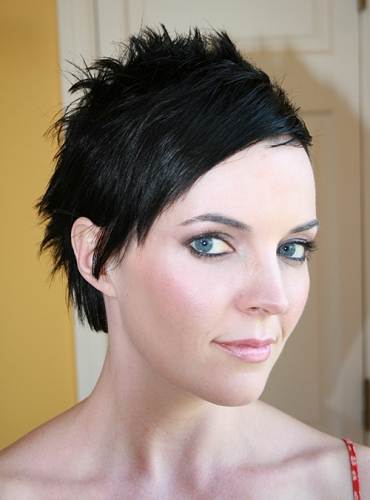
36d Spike, Jennifer Pryor McHugh
So I would say that is the newest hair style I can come up with but I will continue to be interested in all the changes that come up. I've spoken only of some different styles of hair but more people now just style their hair with a brush and a hair blower; that is, those who can manage it. I haven't learned the technique and those of us who haven't still use rollers in our hair to give it a lift. Coloring is really big in this era and we have lots of different ways of doing that. I'm still waiting to see what I will be writing about hair styles in my next 86 yrs. Be assured I will still be watching!!!!!
This long story came about by the discussion of our new antique Barber Chair that had been used so long in our Tuscumbia Barber Shop by many various different Barbers and its long life is now put to rest being donated by its last Barber, Tennyson Jarrett.
Thanks Mom.
We were delighted to host the Camden County Historical Society (photo 37) for their regular meeting in our events and meeting
room on the lower level of the new addition.
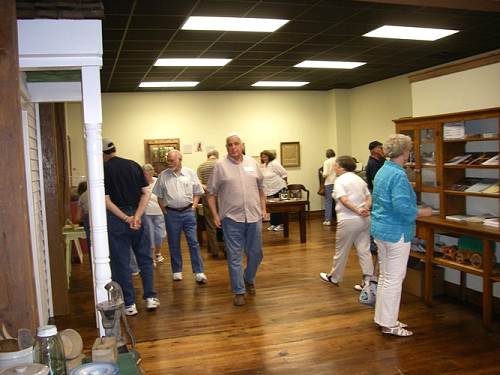
37 Camden County Historical Society
Camden County is much like Miller County regarding the roots of the people who
are long time residents. However, several of the members are later arrivals to the area
having retired to the Lake from various locations around the Midwest or even further away.
We were very pleased by the many complements we received from members of the group about
the way we have designed our new museum. Several regional groups have visited the museum
recently and all comments have been positive and encouraging.
Come and visit us when you can. Our hours are ten a.m. to four p.m. Monday, Wednesday,
Friday, and Saturday.
That's all for this week.
| 


